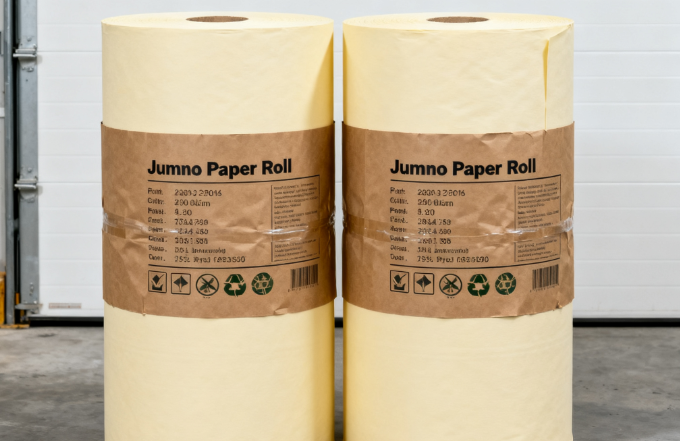Sep 19, 2025

Paper rolls, particularly jumbo rolls, are the unsung workhorses across numerous industries, from commercial printing and packaging to everyday consumer goods. Their extensive use stems from cost-effectiveness and efficiency in high-volume applications. This article delves into the common sizes, materials, and pricing of these large rolls, and highlights a crucial technique for preserving their value when damage occurs.
The specifications of jumbo rolls are primarily defined by their width and diameter, and the choice of material is heavily influenced by the intended application.
Jumbo rolls, also known as parent rolls, are produced in large widths to be later slit into smaller, consumer-sized rolls. Their basic size typically refers to the roll width. Standard widths for industrial paper rolls often include 787 mm, 1092 mm, and 1575 mm, with lengths that can span an impressive 6,000 to 8,000 meters. These rolls are substantial, often weighing several tons each.
| Type | Common Widths (mm) | Common Lengths (meters) | Primary Applications |
|---|---|---|---|
| Newsprint | 787, 1092, 1575 | 6,000 - 8,000 | Newspapers, directories |
| Offset/Book Paper | 787, 850, 1092 | 6,000 - 8,000 | Books, magazines |
| Kraft Paper | 650 - 2,500 (various) | Varies | Packaging, wrapping |
Consumer-grade rolls, like those for bathroom tissue or paper towels, are sourced from these jumbo rolls. Their sizes are often described by their sheet size (e.g., 108mm x 138mm for a 4-ply bathroom tissue roll) and weight per roll (e.g., 130g, 140g, 200g), which indicates thickness and density.
The material composition determines the paper's properties, such as strength, absorbency, and printability.
Newsprint: Made primarily from mechanical wood pulp, it's inexpensive and has good absorbency, making it ideal for newspapers and flyers. However, it contains lignin, which causes it to yellow and become brittle over time.
Coated Paper (Art Paper): This paper is coated with a white mixture to create a smooth, glossy finish. It's excellent for high-quality color printing of items like catalogs, magazines, and premium packaging. Common weights range from 70g/m² to 250g/m².
Kraft Paper: Known for its high strength and durability, it's available in both bleached and unbleached varieties. It's widely used for packaging, wrapping, and producing bags. Basis weights are diverse, ranging from 40g/m² to over 250g/m², and it comes in various widths.
Tissue Paper: Made from virgin or recycled pulp, it's designed for softness and absorbency. It's used in bathroom tissue, paper towels, and napkins. Consumer rolls are often characterized by their ply (layers), such as 2-ply or 4-ply.
Offset Paper: A high-quality, uncoated paper with good ink absorption and surface strength, suitable for books, stationery, and general printing.
The price of a jumbo roll is not a fixed number but is influenced by several dynamic factors:
Raw Material Costs: The cost of pulp, whether virgin wood pulp or recycled pulp, is a primary driver. Global commodity prices for pulp can fluctuate significantly.
Paper Grade and Quality: Higher-quality grades (e.g., premium coated paper, high-strength kraft) command a higher price than standard newsprint or lower-grade packaging paper.
Basis Weight: Heavier papers (higher g/m²) generally cost more than lighter ones, as they use more raw material.
Order Volume: Large bulk purchases typically come with substantial volume discounts.
Market Dynamics: Supply chain logistics, energy costs, and global demand all play a role in determining the final price.
While the search results do not provide explicit, current price lists—as these are often subject to negotiation and change—they indicate that consumer-grade rolls sold online can range from affordable multi-packs for everyday use to higher-priced premium products emphasizing softness, strength, and safety features (e.g., no fluorescent whitening agents).
A significant risk with jumbo rolls, especially in storage or transport, is water damage or external layer contamination. When the outer layers of a massive, valuable roll become wet, dirty, or torn, the instinct might be to write off the entire roll or attempt to manually unwind and discard the damaged section, which is a time-consuming and wasteful process.
This is where a paper roll saw proves to be an invaluable tool. Also known as a core saw or jumbo roll saw, it is a specialized cutting tool designed to cleanly and efficiently remove the outer damaged layers of a paper roll.
Minimizes Waste: Instead of discarding the entire roll, the saw allows operators to precisely cut away only the compromised portion, exposing the intact, high-quality paper underneath.
Saves Time: What would be a tedious manual process becomes a quick and efficient operation, getting production back on track with minimal downtime.
Protects Investment: By salvaging the majority of the roll, the tool preserves the material's value and protects the financial investment in the raw material.
Improves Safety: It provides a controlled and safe method for handling damaged rolls compared to ad-hoc methods using knives or other unsuitable tools.
Using the saw involves securing the roll, setting the cutting depth to avoid damaging the inner layers, and then systematically cutting around the circumference to remove the ruined section. The remaining roll can then be used normally, often with a new wrapper applied to protect the fresh outer layer.
Jumbo paper rolls are fundamental to modern industry and commerce, coming in standardized sizes like 787mm, 1092mm, and 1575mm widths, and made from a variety of materials tailored to specific needs, from absorbent newsprint to sturdy kraft paper. Their pricing is influenced by raw material costs, grade, and order volume.
However, the true test of efficiency often comes when these rolls are damaged. Rather than accepting significant loss, utilizing a paper roll saw offers a smart, rapid solution to remove damaged sections, maximize material utilization, and protect your bottom line. It's a straightforward practice that underscores a commitment to both operational efficiency and resource conservation.
Main Products
Social Media
Social Media
Contact Us
+86 0512 5510 8067
Room 3, No.2159, Beimen Road, Yushan Town, Kunshan City, Jiangsu Province, China
Inquiry
Inquiry
News Center

November 29, 2025

November 24, 2025
Algeria's Paper Packaging Industry: A Rising African Powerhouse